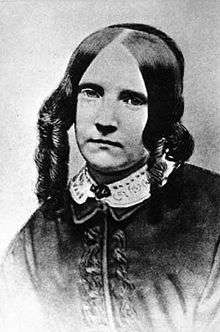Susan Fenimore Cooper
| Susan Fenimore Cooper | |
|---|---|
 Cooper in the 1850s | |
| Born |
Susan Augusta Fenimore Cooper April 17, 1813 Scarsdale, New York, United States |
| Died |
December 31, 1894 (aged 81) Cooperstown, New York, United States |
| Occupation | Writer, founder of orphanage |
| Language | English |
| Period | 19th century |
| Genre | Fiction and natural history |
| Relatives | James Fenimore Cooper (father) |
Susan Augusta Fenimore Cooper (April 17, 1813 – December 31, 1894) was an American writer and amateur naturalist. She founded an orphanage in Cooperstown, New York and made it a successful charity. The daughter of writer James Fenimore Cooper, she served as his secretary and amanuensis late in his life.
Early life, education and charity work
Susan Fenimore Cooper was born in 1813 in Scarsdale, New York, the daughter of the novelist James Fenimore Cooper and his wife Susan Augusta DeLancey. She was his second child, and the eldest to survive her youth. During the later years of her father's life, she became his secretary and amanuensis, and but for her father's prohibition would probably have become his biographer.[1][2]
In 1873, she founded an orphanage in Cooperstown, New York, the town founded by her paternal grandfather William Cooper and where her father had lived for some time. Under her superintendence the orphanage became a prosperous charitable institution. It was begun in a modest house in a small way with five pupils; in 1900 the building, which was erected in 1883, sheltered ninety boys and girls. The orphans were taken when quite young, were fed, clothed, and given a basic education. When they were old enough, they were helped to find positions in “good Christian families.” Some of them before leaving were taught to earn their own living.[1]
In 1886 Cooper established The Friendly Society. Every woman on becoming a member of the Society chose one of the girls in the orphanage to give individual attention.[1]
Authorship

Cooper was a writer who published on diverse subjects, but especially on country life. She kept a diary that formed the basis of her first book, Rural Hours (1850), published anonymously as "by a lady". A sharp-eyed account of rural life in New York, it was illustrated with Cooper's own finely detailed watercolors of local flora and fauna. Cooper wrote two more volumes on country life, but Rural Hours was the most successful, going through six editions over the course of nearly forty years.[3] Cooper also wrote an essay in the form of a letter about women's suffrage and a novel, Elinor Wyllys.
In recent years, beginning with the 1998 republication of Rural Hours, Cooper has begun to achieve recognition as a significant writer in her own right.[4] Rural Hours in particular has been called the "first major work of environmental literary nonfiction by an American woman writer, both a source and a rival of Thoreau's Walden."[4]
Personal life
Her home was built mainly with bricks and materials from the ruins of Otsego Hall in Cooperstown, which her paternal grandfather had built and where her parents had also lived.[1] She died, age 81, in Cooperstown.[1]
Works
- Country Rambles in England; or, Journal of a Naturalist, written by John Leonard Knapp, Notes and Additions by Susan Fenimore Cooper (1853)
| Library resources about Susan Fenimore Cooper |
| By Susan Fenimore Cooper |
|---|
- Elinor Wyllys – A Tale, a novel (ed. by James Fenimore Cooper). 1845. London: Richard Bentley. OCLC 11850952.
- Female Suffrage: A Letter to the Christian Women of America (1870)
- Mt. Vernon to the Children of America (1859)
- Rhyme and Reason of Country Life (1885)
- Rural Hours, a nature diary of Cooperstown, New York, 1850. New York City: George Palmer Putnam. OCLC 428430990.
- Rural Hours. Boston and New York City: Houghton, Mifflin, 1887, at A Celebration of Women Writers
- The Journal of a Naturalist, English edition of Rural Hours (1855)
- The Lumley Autograph (1851, satirical essay)
See also
References
-
 Wilson, James Grant; Fiske, John, eds. (1900). "Cooper, James Fenimore". Appletons' Cyclopædia of American Biography. New York: D. Appleton. The note about her being the eldest of the children to survive her youth is from the 1889 edition.
Wilson, James Grant; Fiske, John, eds. (1900). "Cooper, James Fenimore". Appletons' Cyclopædia of American Biography. New York: D. Appleton. The note about her being the eldest of the children to survive her youth is from the 1889 edition.
- Daniel Patterson: Susan Fenimore Cooper. In: Daniel Patterson (ed.), Roger Thompson (ed.), J. Scott Bryson (ed.): Early American Nature Writers: A Biographical Encyclopedia. Greenwood,2008, ISBN 9780313346804, pp. 89–95
Notes
- 1 2 3 4 5
 Wilson, James Grant; Fiske, John, eds. (1900). "Cooper, James Fenimore". Appletons' Cyclopædia of American Biography. New York: D. Appleton.
Wilson, James Grant; Fiske, John, eds. (1900). "Cooper, James Fenimore". Appletons' Cyclopædia of American Biography. New York: D. Appleton. - ↑ Daniel Patterson: Susan Fenimore Cooper. In: Daniel Patterson (ed.), Roger Thompson (ed.), J. Scott Bryson (ed.): Early American Nature Writers: A Biographical Encyclopedia. Greenwood,2008, ISBN 9780313346804, pp. 89-95
- ↑ Kramer, Jack. Women of Flowers. New York: Stewart, Tabori & Chang, 1996, pp. 86–89.
- 1 2 Johnson, Rochelle, and Daniel Patterson, eds. Susan Fenimore Cooper: New Essays on Rural Hours and Other Works. Athens: University of Georgia Press, 2001.
External links
| Wikisource has original works written by or about: Susan Fenimore Cooper |
- Susan Fenimore Cooper page from James Fenimore Cooper Society Website
- Works by Susan Fenimore Cooper at Project Gutenberg
- Works by or about Susan Fenimore Cooper at Internet Archive
- Works by Susan Fenimore Cooper at LibriVox (public domain audiobooks)

- Works by Susan Fenimore Cooper at The Online Books Page
- Essays by Susan Fenimore Cooper at Quotidiana.org
|